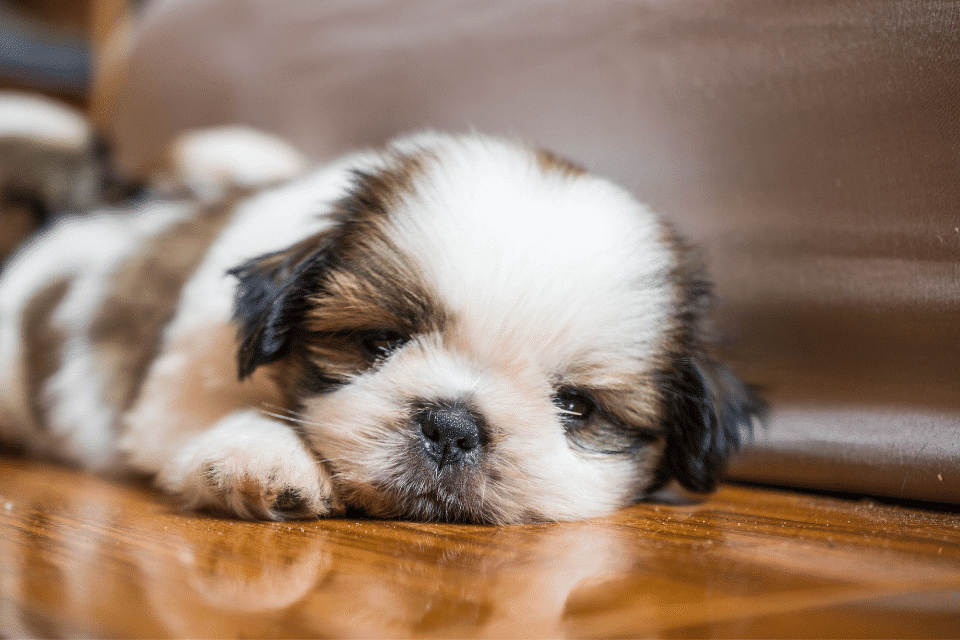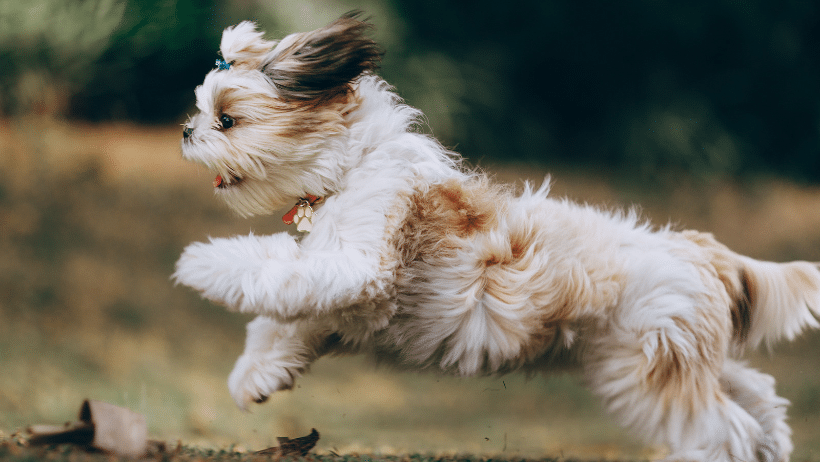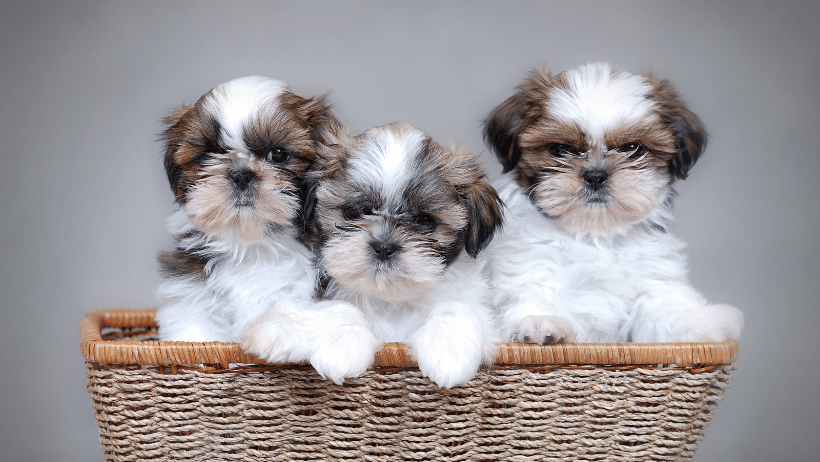
Newborn Shih Tzu puppies begin to make noises shortly after their eyes open. They will also begin to try and get up and waddle around the whelping box at this time. Between three and four weeks you might want to provide newborn Shih Tzu puppies with a new safe daytime area for extra stimulation. A new larger area physically stimulates and mentally challenges newborn Shih Tzu puppies.
Be sure the new area has good footing. Before this time the Shih Tzu dam may protest about moving her offspring. In about three or four weeks, however, the Shih Tzu dam will agree to a new spot. The dog’s earliest ancestors that were related to the wolf actually utilized several den sites. The first den was used for whelping. The second den was always larger to provide the offspring with safe areas of exploration. Once Shih Tzu puppies are large enough to clamber out of the whelping box, they need an area large enough to clearly define sleeping, eating, playing, and toilet areas.
If you are using your garage or basement to raise Shih Tzu puppies please check for conditions that can be dangerous or lethal. Stairwells
A safe play area can be created by using a garage’s side door to the yard. Block the areas under and around the door from cold and damp drafts. Flooring should have a firm, no slippery surface.
Line your whelping box with clean soft blankets or towels in the beginning. If carpeting is used, it should be washable. Do not use indoor/outdoor carpeting. Manufacturing chemicals can react with the urine. The use of these materials can cause burns to the bodies of Shih Tzu puppies. Do not use newspapers in the whelping box. Newspapers are slick and contain chemicals used in the ink. Do not use wood shavings in the whelping box. Wood shavings can be inhaled or ingested which also can cause fatalities.
When newborn Shih Tzu puppies begin to move around inside the box, house training can be stimulated by separating the whelping box into two areas, sleeping and eliminating. Even very young Shih Tzu puppies do not like to eliminate where they sleep, eat and play. Within a few days, puppies learn to move away from their sleeping area to eliminate. Use removable sides in the whelping box to encourage them to sleep in the whelping box and eliminate them away from it. If you use a heat lamp, use it only in the sleeping and playing areas.
The Shih Tzu dam will require an area close to her Shih Tzu puppies but also a place where she can relax away from them.
Healthy newborn Shih Tzu puppies will sleep on top of each other. Once out of the whelping box a small airline crate with the door
Below is a nice summary of how to raise newborn Shih Tzu puppies. We hope you find it useful:
- How do you take care of a newborn Shih Tzu? Taking care of a newborn Shih Tzu involves several steps, such as keeping them warm and clean, feeding them appropriately, monitoring their health, and providing them with a comfortable and safe environment. Here are some tips for taking care of a newborn Shih Tzu:
-
- Keep the puppies in a warm and comfortable environment, as they are not able to regulate their body temperature yet.
- Ensure that the puppies are well-fed, either by nursing from their mother or by bottle-feeding them with a formula that is specifically made for puppies.
- Clean the puppies regularly by gently wiping them with a damp cloth. Be careful not to get water in their ears or mouth.
- Monitor the puppies’ health and look out for any signs of illness, such as vomiting or diarrhea.
- Handle the puppies gently, and avoid stressing them out by handling them too much.
According to The Goody Pet1, newborn Shih Tzus puppies are prone to developing infections. So it’s important to ensure their space is clean. Shih Tzus are not born with their long, magnificent coats. The shorter newborn coat is not always adequate to keep the puppies warm. If you can, get a portable heater or heating pad to keep them nice and toasty. You could also line their space with warm blankets and set them up in a warm part of your home. After all is said and done, the best thing you can do for a newborn Shih Tzu is to take care of its mother.
- How big are newborn Shih Tzu puppies? Newborn Shih Tzu puppies are usually small, weighing between 3-7 ounces (85-198 grams) at birth. They are also very fragile and require a lot of care and attention.
- What do you feed a newborn Shih Tzu? Newborn Shih Tzu puppies should ideally be fed with their mother’s milk, as it provides all the necessary nutrients they need to grow and develop. If the mother is unable to nurse the puppies or if the puppies are orphaned, then they can be fed a commercial puppy formula that is specially formulated for their nutritional needs. As for feeding, according to The EcoBaby2, a baby Shih Tzu should eat about 1/4 to 1/2 a cup of food per day. Shih Tzu puppies should be fed on a schedule 5-6 times daily as they are prone to hypoglycemia. Check the label on the food bag for the brand’s instructions as to the portion amounts.
-
When can a Shih Tzu puppy leave its mother? Shih Tzu puppies should ideally stay with their mother until they are at least 8-10 weeks old, as this allows them to properly socialize with their littermates and learn important behaviors from their mother. Taking a puppy away from its mother too early can lead to behavioral and health issues later on.
-
Finally, according to Petco3, some of the most common Shih Tzu health issues involve their eyes, and pigmentary keratitis is prominent in other brachycephalic breeds like pugs and bulldogs. Other common health problems include hip dysplasia, brachycephalic obstructive airway syndrome (BOAS), collapsing trachea, liver shunts, and more.
{CONTENTPOLL [“id”: 42]}
Do you have new Shih Tzu puppies or are you considering breeding your dog? Let us know below in the comment section how your experience went (or is going!). Any information or advice you can share might be very helpful to others who are considering the same thing.




